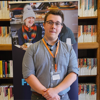On Friday 13 June, Fight for Sight hosted its first Early Career Researcher (ECR) Network event to help ECRs grow their network right from the beginning of their research journey.
We spoke to Dr Wyn Firth, a post-doctoral researcher, who won the image contest on the day for his image of lab-grown neurons. Dr Firth described the day as ‘extremely valuable.’
He said: ‘You need these opportunities to get to know the next generation of Principal Investigators (PIs) that you might meet at the big conferences.’
The importance of networking early on
The journey as an early career researcher can last ‘up to 10 years post PhD,’ says Dr Firth.
It’s a critical phase of any researcher’s career, one that’s mostly spent in the lab, making it hard to network with your peers.
Being an ECR isn’t always easy, with pressure to build up your portfolio and the highly competitive nature of early postdoctoral fellowships.
Talking about opportunities like Fight for Sight’s Early Career Research event, Dr Firth said: ‘It lets us build networks that we otherwise wouldn’t build within our institution…it focuses in on a particular population of budding scientists.’
Head of Impact at Fight for Sight, Eleanor Southwood said: 'Bringing together members of our early career community is vital for building the next generation of vision researchers. We are incredibly grateful to all of our supporters for making this critical work possible.'
"Bringing together members of our early career community is vital for building the next generation of vision researchers. We are incredibly grateful to all of our supporters for making this critical work possible."
Life in the lab
Dr Firth is a post-doctoral researcher in Professor Votruba’s lab at Cardiff University. His current project is looking at an inherited condition called Leber’s hereditary optic neuropathy (LHON).
Their team is trying to understand why some people with the condition have spontaneous visual recovery, and whether they can use this knowledge to help those who don’t.
When asked what his day-to-day can look like, Dr Firth said that he spends a lot of time in ‘a cell culture facility, which is effectively a fancy cabinet with an air control system in place to maintain the sterile environment.’
He is often rushing from experiment to experiment, making solutions, keeping on top of recent publications, taking images on the microscope, or approaching potential collaborators.
The image that he won the ECRN event contest with was taken when he was on the microscope, looking at stem cells taken from patients. These stem cells have been turned into special retinal cells called ‘retinal ganglion cells.’
Talking about the image, Dr Firth said: ‘We're trying to look at how they form networks. You can see how in the image the cells are reaching out and touching each other. We think potentially cells with recovery capacity might retain some of that networking ability.’
Connecting with patients
One of the most important parts of the day for Dr Firth was the Patient and Public Involvement and Engagement (PPIE) session.
‘I thought it was really powerful, I grow things in plastic dishes to model disease. I have very little day-to-day contact with patients affected by LHON.’
PPIE is becoming an increasingly important element of medical research. By involving patients in the grant application process, we can assess research not just on its scientific validity, but also on how it can have meaningful impact for patients.
‘It was particularly moving for me to see how my work can make a difference one day, even though it may be a long way off.’

"It was particularly moving for me to see how my work can make a difference one day, even though it may be a long way off."
The Early Career Researcher journey
When asked what’s next, Dr Firth said: ‘I’m hoping to keep working on metabolic disorders, but all of that depends on limited opportunities for grants.’
Fight for Sight is working to fill this gap by continuing to support excellent science.
‘If you just keep applying yourself and stay motivated, you tend to work out a solution. If I could give one piece of advice to a PhD student or an earlier ECR, it would be to just keep going. It’s a marathon, not a sprint.’
He also added that he’d advise making use of any opportunities to network with peers: ‘Support from peers can help you think about things in ways that you otherwise wouldn't, taking your work to the next level.’
If you would like to get involved with the network, please contact grants@fightforsight.org.uk
Latest from our research blog

Related content






